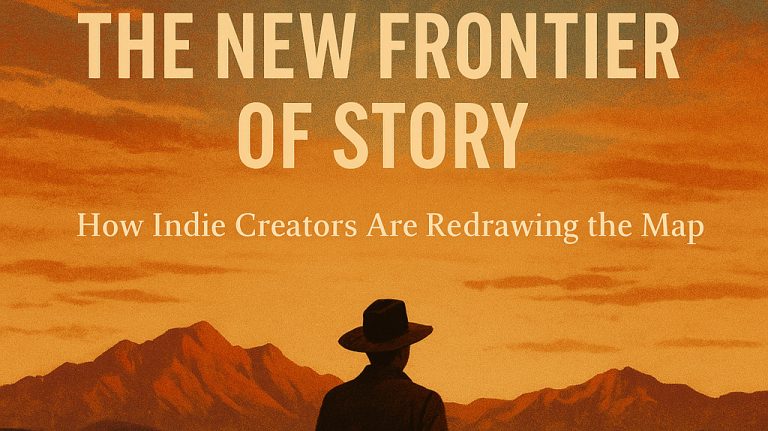When I first began writing Ephemeris, I assumed I’d follow the path so many authors dream about: query agents, land a book deal, and watch the machine of traditional publishing bring my story into the world. It’s the route we’ve been told is the “real” way to become an author. But the deeper I got into this book, the more I realized that the “real” way is whichever way ensures the book you’ve written is the book that reaches readers. And for Ephemeris, that meant breaking from the traditional model entirely.
Instead, I made a decision that felt both terrifying and freeing: I would form my own self-publishing company and release Ephemeris myself.
The Moment I Knew
This wasn’t a snap decision. I’ve spent years in communications, marketing, and storytelling – fields that taught me not only how to write, but how to package, present, and distribute ideas. The more I learned about the realities of traditional publishing (multi-year timelines, loss of creative control, limited say in cover design and marketing) the more I realized that the skill set I already had was the same one many publishers would be charging me a royalty to use.
Then came the deeper truth: Ephemeris is a book I can’t imagine surrendering. Its structure, its tone, even the way the cover will look…these aren’t just aesthetic choices, they’re part of its DNA. Handing that over to a corporate publishing process felt like diluting something personal and precise.
The Control Factor
A lot of authors talk about “creative control” when discussing self-publishing, but for me it’s more than choosing my own cover. It’s about controlling:
- The schedule: Traditional publishers often work two years ahead. If I finished Ephemeris in 2025, it might not hit shelves until 2027. By self-publishing, I control the release window and can time it with my marketing momentum.
- The design: I know exactly how I want the book to feel in someone’s hands – the paper weight, the typography, the chapter headers. That detail work is usually invisible to readers, but not to me.
- The brand: I can build a consistent, recognizable look for Ephemeris and future books, so readers know they’re picking up a ColePress title before they even see my name.
The Business Mindset
If I’d simply decided to self-publish without the structure of a company, it might have been easier in the short term. But I wanted more than a one-off release. I wanted to create a platform for future work – mine and potentially others’.
By forming a publishing imprint, I’m not just releasing a book; I’m establishing a business entity with its own ISBN block, branding, and publishing pipeline. This allows me to:
- Keep all my intellectual property rights.
- Control pricing and promotions without negotiating with a publisher.
- Develop a repeatable process for editing, production, and marketing that I can apply to future books.
This isn’t just about Ephemeris…t’s about building something sustainable.
The Financial Math
People sometimes assume traditional publishing means the publisher pays for everything. And that’s true…if you define “everything” as what they’re willing to invest in. The reality is, most debut authors get modest advances, many marketing costs come out of their own pocket anyway, and royalties are often small after the publisher takes their cut.
With self-publishing, yes, I’m fronting the costs for editing, design, and printing. But the math changes when I sell a copy: instead of a small percentage, I keep the bulk of the revenue. That means fewer sales are needed to break even, and I retain control over pricing for special editions, bundles, or digital promotions.
The Risks and Rewards
Self-publishing is not without its risks. There’s no built-in distribution team to get my book into every bookstore in the country. There’s no name-brand publisher to impress industry insiders. And if the book flops, I can’t blame anyone but myself.
But the rewards? They’re equally stark:
- Every design choice is mine.
- Every marketing move is mine.
- Every dollar the book earns comes directly back to my company.
- Most importantly, the book that exists in my head is the one readers will hold in their hands.
Building a Launch Plan
Creating a publishing company means thinking beyond just the book’s content: it’s about orchestrating an entire launch strategy. For Ephemeris, that includes:
- Professional Editing: Multiple rounds to ensure polish without losing the voice.
- Custom Cover Design: Developed in collaboration with a designer who understands sci-fi and the specific atmosphere I want to convey.
- Pre-Launch Marketing: Blog posts, behind-the-scenes newsletters, and social media teasers to build anticipation.
- Early Reader Program: Sending advance copies to select readers for reviews and word-of-mouth momentum.
- Multiple Formats: Hardcover, paperback, e-book, and possibly an audiobook to reach the widest audience.
The Emotional Side of Independence
It’s easy to talk about this like a purely strategic decision, but there’s an emotional side, too. Publishing Ephemeris under my own imprint feels like putting my name not just on a book, but on the entire ecosystem that brings it to life.
There’s pride in knowing that when someone asks, “Who’s your publisher?” I get to say, “I am.” It’s not about ego, it’s about ownership in the truest sense.
An Invitation to Join Me
Here’s the part where I break the fourth wall a little: if you’ve been following the journey of Ephemeris, you know this book is more than just a story. It’s a mosaic of voices, visions, and possibilities. And as part of launching it independently, I’m building something I want to share with the people who’ve been cheering me on.
That’s why I’ll be offering exclusive behind-the-scenes content: cut chapters, alternate artwork, and commentary you won’t see anywhere else, through my newsletter. In fact, some of the deleted material is rich enough to stand alone as short fiction, and you’ll get it months before anyone else.
Traditional publishing often locks this kind of content away for “special editions” or after-the-fact releases. But here, the curtain stays open.
Final Thoughts
Choosing to self-publish isn’t a rejection of traditional publishing…it’s an embrace of the tools, skills, and freedoms I already have. For Ephemeris (and other books to follow), it’s the only path that feels honest.
When the book lands in your hands, it will be the version I imagined from the first keystroke. And when you flip that last page, you’ll know that every decision – from the first word to the final printing – was made by the person who cared most about the story.







